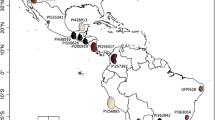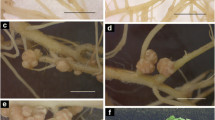Abstract
Strains of Rhizobium tropici IIB, CIAT899 and F98.5, both showing good N2 fixation, and a R. etli strain W16.3SB were introduced into a field which had no history of bean culture. Plant dilution estimates showed that in the presence of its host (Phaseolus vulgaris cv. Carioca) during the cropping seasons and the subsequent fallow summer periods, the bean rhizobial populations increased from less than 30 to 103 g−1 dry soil after 1 year and to 104 g−1 dry soil after 2 years. In the 1st year crop, the inoculated strains occupied most of the nodules, which resulted in a higher nodulation and C2H2 reduction activity. Without reinoculation for the second and third crops, however, little R. tropici IIB was recovered from the nodules and the bean population consisted mainly of R. etli, R. leguminosarum bv. phaseoli, and R. tropici IIA. Reinoculation with our superior R. tropici IIB strains before the second crop resulted in R. tropici IIB occupying the main part of the nodules and a positive effect on nodulation and C2H2 reduction activity, but reintroduction of the inoculant strain in the third season did not have any effect.
Similar content being viewed by others
References
Abaidoo RC, George T, Bohlool BB, Singleton PW (1990) Influence of elevation and applied nitrogen on rhizosphere colonization and competition for nodule occupancy by different rhizobial strains on field-grown soybean and common bean. Can J Microbiol 36:92–96
Almeidade, DL, Santos GdeA, De-Polli H, Cunha LH, Freire LR, Sobrinho NMBdoA, Pereira NNC, daEira PA, Bloise RM, Salek RC (1988) Manual de adubação para e estado do Rio de Janeiro. Universidade Rural, Itaguaí, R.J. Coleção Universidade Rural, Série Ciências Agrárias No. 2
Asad S, Malik KA, Hafeez FY (1991) Competition between inoculated and indigenous Rhizobium/Bradyrhizobium spp. strains for nodulation of grain and fodder legumes in Pakistan. Biol Fertil Soils 12:107–111
Beattie GA, Clayton MK, Handelsman J (1989) Quantitative comparison of the laboratory and field competitiveness of Rhizobium leguminosarum biovar phaseoli. Appl Environ Microbiol 55:2755–2761
Borthakur D, Downie JA, Johnston AWB, Lamb JW (1985) psi, A plasmid-linked Rhizobium phaseoli gene that inhibits exopolysaccharide production and which is required for symbiotic nitrogen fixation. Mol Gen Genet 200:278–282
Cunningham SD, Munns DA (1984) Effects of rhizobial extracellular polysaccharide on pH and aluminium activity. Soil Sci Soc Am J 48:1276–1279
Davis EO, Johnston AWB (1990) Analysis of three nodD genes in Rhizobium leguminosarum biovar phaseoli; nodDl is preceded by nolE, a gene whose product is secreted from the cytoplasm. Mol Microbiol 4:921–932
Duque FF, Neves MCP, Franco AA, Victoria RL, Boddey RM (1985) The responses of field grown P. vulgaris to Rhizobium inoculation and the quantification of N2 fixation using 15N. Plant and Soil 88:333–343
Franco AA, Munns DN (1982) Acidity and aluminium restraints on nodulation, nitrogen fixation and growth of Phaseolus vulgaris in solution culture. Soil Sci Soc Am J 46:296–301
Graham PH, Viteri SE, Mackie F, Vargas AAT, Palacios A (1982) Variation in acid soil tolerance among strains of Rhizobium phaseoli. Field Crop Res 5:121–128
Hernandez-Armenta R, Wien HC, Eaglesham ARJ (1989) Maximum temperature for nitrogen fixation in common bean. Crop Sci 29:1260–1265
Hilali A, Aurag J, Molina JAE, Schmidt EL (1989) Competitiveness and persistence of strains of Rhizobium phaseoli introduced into a Maroccan sandy soil. Biol Fertil Soils 7:213–218
Hungria M, Franco AA, Sprent JI (1993) New sources of high-temperature tolerant rhizobia for Phaseolus vulgaris L. Plant and Soil 149:103–109
Karanja NK, Wood M (1988) Selecting Rhizobium phaseoli strains for use with beans (Phaseolus vulgaris L.) in Kenya: Tolerance of high soil temperature and antibiotic resistance. Plant and Soil 112:15–22
Kucey RMN (1989) Responses of field bean (Phaseolus vulgaris L.) to levels of Rhizobium leguminosarum bv. phaseoli inoculation in soils containing effective R. leguminosarum bv. phaseoli populations. J Plant Sci 69:419–426
Kucey RMN, Hynes MF (1989) Populations of Rhizobium leguminosarum biovars phaseoli and viciae in fields after bean or pea in rotation with nonlegumes. Can J Microbiol 35:661–667
Martílnez E, Pardo MA, Palacios R, Cavallos MA (1985) Reiteration of nitrogen firxation gene sequences and specificity of Rhizobium in nodulation and nitrogen fixation in Phaseolus vulgaris. J Gen Microbial 131:1779–1786
Martínez E, Flores M, Brom S, Romero D, Dávilla G, Palacios R (1988) Rhizobium phaseoli: A molecular genetics view. Plant and Soil 108:179–184
Martínez-Romero E, Segovia L, Mercante FM, Franco AA, Graham P, Pardo MA (1991) Rhizobium tropici, a novel species nodulating Phaseolus vulgaris L. beans and Leucaena spp. trees. Int J Syst Bacteriol 41:417–426
McDermott TR, Graham PH (1989) Bradyrhizobium japonicum inoculant mobility, nodule occupancy, and acetylene reduction in the soybean root system. Appl Environ Microbiol 55:2493–2498
Moxley JC, Hume DJ, Smith DL (1986) N2 fixation and competitiveness of Rhizobium phaseoli strains isolated from Ontario soils. Can J Plant Sci 66:825–836
de Oliveira LA, Graham PH (1990) Evaluation of strain competitiveness in R. leguminosarum by. phaseoli using a nod + fix −natural mutant. Arch Microbiol 153:105–310
Piha MI, Munns DN (1987) Sensitivity of the common bean (Phaseolus vulgaris L.) symbiosis to high soil temperature. Plant and Soil 98:183–194
Quinto C, de laVega H, Flores M, Fernáandez L, Ballado T, Soberón G, Palacios R (1982) Reiteration of nitrogen fixation gene sequences in Rhizobium phaseoli. Nature (London) 299:724–726
Ramos MLG, Boddey RM (1987) Yield and nodulation of Phaseolus vulgaris and the competitivity of an introduced Rhizobium strain: Effects of lime, mulch and repeeated cropping. Soil Biol Biochem 19:171–177
Ramos DP, de Castro AF, Camargo MN (1973) Levantamento detalhado de solos da área de Universidade Federal Rural de Rio de Janeiro. Pesqui Agropecu Bras Ser Agron 8:1–27
Rennie RJ, Kemp GA (1983) N2 fixation in field beans quantified by N15 isotope dilution. I. Effect of strains of R. phaseoli. Agric J 75:640–644
Robert FM, Schmidt EL (1983) Population changes and persistence of Rhizobium phaseoli in soils and rhizospheres. Appl Environ Microbiol 45:550–556
Segovia L, Young JPW, Martínez-Romero E (1993) Reclassification of American R. leguminosarum biovar phaseoli type I strains as Rhizobium etli sp. nov. Int J Syst Bacteriol 43:374–377
Slattery JF, Coventry DR (1993) Variation of soil populations of Rhizobium leguminosarum bv. trifolii and the occurrence of inoculant rhizobia in nodules of subterranean clover after pasture renovation in north-eastern Victoria. Soil Biol Biochem 25:1725–1730
Straliotto R, Mercante FM, James EK, Neves MCP, Franco AA (1992) Tolerance of bean (Phaseolus vulgaris L.) symbiosis with Rhizobium tropici to heat shock. In: Palacios R, Mora J, Newton WE (eds) New horizons in nitrogen fixation. Kluwer Academic Publishers, Dordrecht Boston London, pp 745
Streit W, Kosch K, Wemer D (1992) Nodulation competitiveness of Rhîzobium leguminosarum bv. phaseoli and Rhizobium tropici strains measured by glucuronidase (gus) gene fusion. Biol Fertil Soils 14:140–144
Thies YE, Singleton PW, Bohlool BB (1991) Influence of the size of indigenous rhizobial populations on establishment and symbiotic performance of introduced rhizobia on field grown legumes. Appl Environ Microbiol 57:19–28
Van Rheenen HA (1982) Bean research in Eastern Africa. Report from the National Dry Bean Council Research Conference, Gainsville, Malawi
Vargas AAT, Graham PH (1988) Phaseolus vulgaris cultivar and Rhizobium strain variation in acid-pH tolerance and nodulation under acid conditions. Field Crop Res 19:91–101
Vargas AAT, Graham PH (1989) Cultivar and pH effect on competition for nodule sites between isolates of Rhizobium in beans. Plant and Soil 117:195–200
Vázquez M, Dávalos A, de lasPeñas A, Sánchez F, Quinto C (1991) Novel organization of the common nodulation genes in Rhizobium leguminosarum by phaseoli strains. J Bacteriol 173:1250–1258
Vincent JM (1970) A manual for the practical study of the root-nodule bacteri. IBP Handbook 15, Blackwell Scientific Publications, Oxford Edinburgh
Wolff AB, Streit W, Kipe-Nolt JA, Vargas H, Werner D (1991) Competitiveness of R. leguminosarum bv. phaseoli strains in relation to environmental stress and plant defense mechanisms. Biol Fertil Soils 12:170–176
Author information
Authors and Affiliations
Rights and permissions
About this article
Cite this article
Vlassak, K., Vanderleyden, J. & Franco, A. Competition and persistence of Rhizobium tropici and Rhizobium etli in tropical soil during successive bean (Phaseolus vulgaris L.) cultures. Biol Fertil Soils 21, 61–68 (1996). https://doi.org/10.1007/BF00335994
Received:
Issue Date:
DOI: https://doi.org/10.1007/BF00335994




